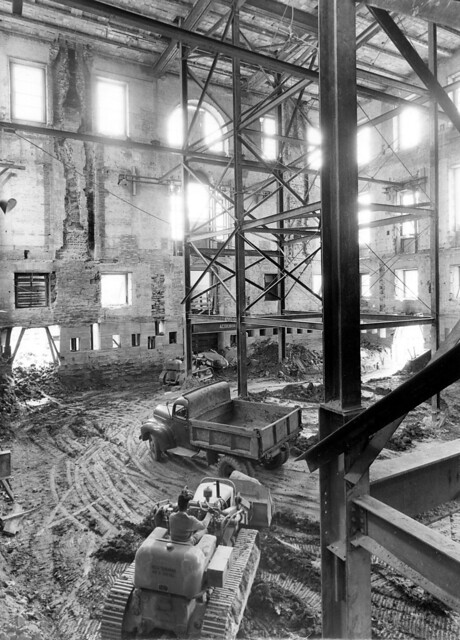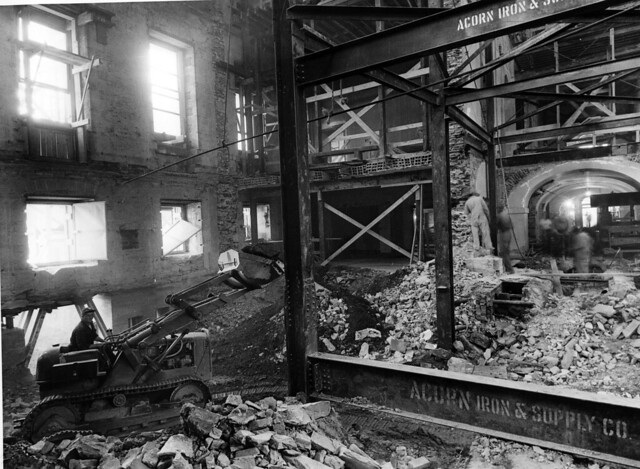White House reconstruction
February 26, 2013 at 10:52 PM by Dr. Drang
Mashable and the National Journal have posted a wonderful series of old photos of the inside of the White House during its gutting and reconstruction in the Truman administration. The exterior walls were braced and left standing while the interior timber framework was replaced with steel.
Photo from Mashable
I was particularly struck by this photo and its caption.
Photo from Mashable
A bulldozer removing debris from the inside of the White House, during the renovation of the building. The bulldozer had to be taken apart and moved into the White House in pieces, as President Truman would not allow a hole large enough to fit the bulldozer to be cut into the walls of the White House.
You might think that taking a loader1 apart and reassembling it inside a building was an unusual requirement for a very special project, but it wasn’t.2
My dad was an engineer at Caterpillar for over 30 years, and in the early part of his time with the company, he did a lot of customization work. This typically involved him going onto the factory floor, pulling a machine out of the normal production line, and having it sent to the custom shop for fitting out with special accessories. This always got him an earful of colorful language from the line foremen whose work he was interrupting, but it gave him hands-on experience with all the machines they made at the plant.
One of the customizations he had to supervise was for tractors that were going to work in underground mines. The mines’ entrance shafts were much smaller than the machines, so it was common to send them down in pieces to be assembled in the mine. In some cases, though, that wasn’t sufficient. The shaft space in these mines was so restricted that the machine’s frame would actually have to be cut in half in the plant and then welded back together down in the mine. Dad’s job was to make sure the cuts in the frame were done where the stresses were the lowest so the frames would survive even if the welding in the mine wasn’t of the highest quality—which, given the conditions, it seldom was.
These machines never saw the light of day again. When the mine played out, they were left behind. It was too expensive to bring up well-used equipment.
Dad’s not around to share these photos with, but I know he would have enjoyed them. I’m sure he would’ve found something critical to say about the loader, too—it’s an Allis-Chalmers.
Update 2/27/13
I didn’t realize when I wrote this that there are more photos of the reconstruction in the National Archives’ Flickr photostream. They’re not organized in a set, so just start at this one and look around.
-
The machine in the photo is a loader, not a bulldozer. The National Journal writer, Brian Resnick, has made the common mistake of thinking anything with crawler tracks must be a bulldozer, but when there’s a bucket at the front instead of a blade the machine is a loader. It’s commonly called a front end loader because of where the bucket is. Most loaders are on wheels and are formally known as wheel loaders; this one would be the less common track loader. ↩
-
I am, by the way, somewhat suspicious of the story that Truman wouldn’t allow a hole big enough for the loader to drive through. Where did the dump truck in the top photo take its load of debris? ↩



